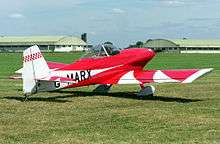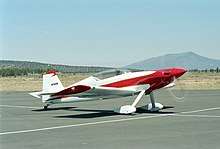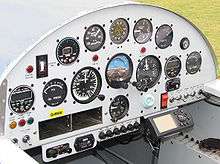Van's Aircraft RV-4
The Van's RV-4 is an American light homebuilt aircraft supplied in kit form by Van's Aircraft of Aurora, Oregon. It seats two people in a tandem seating configuration with the pilot accommodated in the front seat.[2]
| RV-4 | |
|---|---|
 | |
| Role | RV-4 |
| National origin | United States |
| Manufacturer | Van's Aircraft |
| Designer | Richard VanGrunsven |
| First flight | August 1979 |
| Introduction | 1980 |
| Number built | 1436 (October 2019)[1] |
| Unit cost |
USD$37,000-$73,000 |
| Developed from | Van's Aircraft RV-3 |
The Van's RV series has become the most popular kit-built aircraft in the world.[3] As of April 2019, the RV-4 is the fourth most popular RV model.[1]
As of October 2019, 1436 RV-4s had been completed and flown worldwide.[1]
Development



Richard VanGrunsven designed the RV-4 in the mid 1970s as a two-seat development of the single-seat RV-3. The RV-4 prototype first flew in August 1979.
The RV-4 is a new design based upon the concepts proven in the RV-3 and is not merely a stretched RV-3. The RV-4 airframe will accept a range of engines up to 180 hp (134 kW), including the Lycoming O-360. The RV-4 has a new wing, with increased wingspan and wing area over the RV-3. The RV-4 is designed for sport aerobatics.
The RV-4 has proven to be a capable cross country aircraft in service, able to carry two modest sized people and baggage on longer trips. RV-4s have been flown around the world, notably by an Australian, Jon Johanson, who completed world-girdling RV-4 flights on two occasions.
Many larger people find the RV-4 cockpit design physically constraining, and as a result VanGrunsven has designed an entire family of derivative designs. The RV-6 was designed to allow side-by-side seating, and the RV-8 was created as an enlarged aircraft that follows the RV-4's philosophy and offers tandem seating in a bigger aircraft.
Unlike most later RV series designs, RV-4 kits are only available with conventional landing gear, although some may have been constructed in tricycle configuration by builders. At least two RV-4s have also been built with retractable landing gear (mostly for the engineering challenge, as the performance gains were modest).
Variants
- RV-4
- Basic version
- Harmon Rocket
- Higher performance derivative of the RV4, with clipped wings, a 300 hp (224 kW) Lycoming IO-540 engine and a razorback turtledeck.[4]
Specifications (Typical RV-4)

Data from manufacturer[5]
General characteristics
- Length: 20 ft 4 in (6.20 m)
- Wingspan: 23 ft (7.0 m)
- Height: 5 ft 5 in (1.65 m)
- Wing area: 110 sq ft (10 m2)
- Empty weight: 903 lb (410 kg) minimum
- Gross weight: 1,500 lb (680 kg)
- Fuel capacity: 32 U.S. gallons (120 L; 27 imp gal)
- Powerplant: 1 × Lycoming O-360 four cylinder piston aircraft engine, 180 hp (130 kW)
- Propellers: 2-bladed fixed pitch or constant speed propeller
Performance
- Maximum speed: 212 mph (341 km/h, 184 kn)
- Cruise speed: 200 mph (320 km/h, 170 kn) 75% power at 8,000 ft
- Stall speed: 54 mph (87 km/h, 47 kn)
- Range: 590 mi (950 km, 510 nmi)
- Service ceiling: 23,000 ft (7,000 m)
- Rate of climb: 1,950 ft/min (9.9 m/s)
- Wing loading: 13.64 lb/sq ft (66.6 kg/m2)
- Power/mass: 8.33 lb/hp
See also
Related development
Aircraft of comparable role, configuration and era
References
- Vans Aircraft (October 2019). "First Flights". Retrieved 18 October 2019.
- Vandermeullen, Richard: 2011 Kit Aircraft Buyer's Guide, Kitplanes, Volume 28, Number 12, December 2011, page 74. Belvoir Publications. ISSN 0891-1851
- "Homebuilt Airplanes & Van's RV - EAA Museum". www.eaa.org. Retrieved 20 May 2019.
- "Harmonrocket". Harmonrocket. Retrieved 20 May 2019.
- Van's Aircraft. "RV-4". www.vansaircraft.com. Archived from the original on 20 May 2019. Retrieved 20 May 2019.